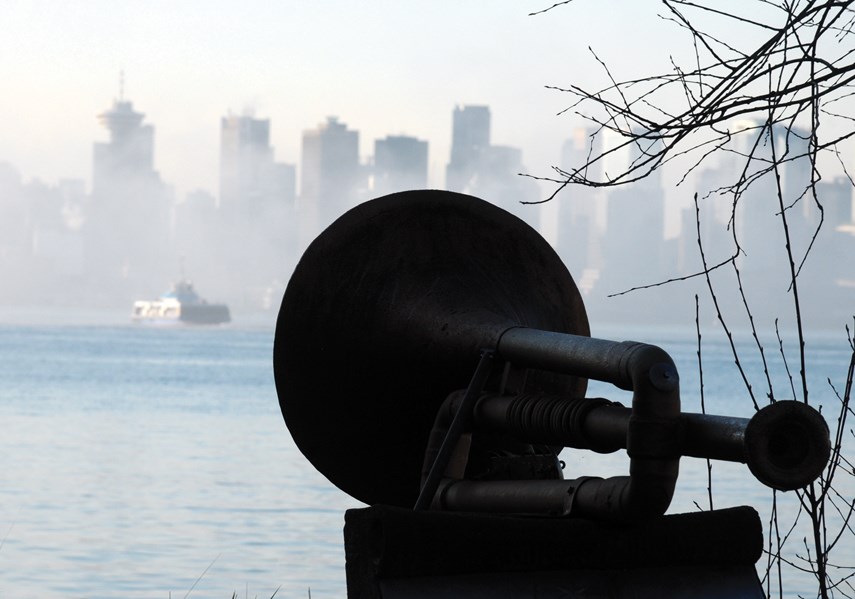Like a trumpet’s blare fighting its way through a dense maritime fog, the story of how one-armed local legend Joe Bustemente kept our ferries on course is out there floating through the mists of time.
I thought of Joe Bustemente this last fortnight as fog squatted down on Burrard Inlet and, like a house guest who overstays his welcome, settled in for more than a week.
These days fog on the water is more a curiosity than a crisis, a great photo op that is made all the more charming – except for those in blast range trying to get some sleep – by the horns of cargo ships calling out their sightless cries. Today the SeaBus is outfitted with all the modern radar technology needed to find its way from Vancouver to the North Shore even through the thickest soup. But things were different in the days before the bleeps and bloops could guide the way.
How did ferries find their way across the sopped-in inlet 100+ years ago – when the many mills dotting the shoreline made fog all the worse – without bashing into each other or missing their mark by a nautical mile?
They didn’t always. The history buffs at the North Vancouver Museum and Archives tell a story of a North Vancouver-bound ferry that left its Vancouver dock on Columbia Street in a dense fog. After completing the sailing the captain instructed the passengers to disembark, only to be informed by the passengers that they were not in North Vancouver at all but rather right back at the same Vancouver dock that they had just departed.
Some stories had sadder endings. The West Vancouver Museum has an account of a tragedy involving West Vancouver Ferry No. 5. The vessel was navigating thick fog at a slow speed approaching Prospect Point when the massive CPR ship Princess Alice, 47 minutes late inbound from Seattle, appeared out of the fog. The bow of the Alice cut through the ferry on the port side, causing catastrophic damage to the No. 5 and tragically pinning elderly passenger Mrs. William E. Burritt to the side of the cabin. Captain and crew of the No. 5 tried valiantly to rescue her as the ferry quickly began to sink, but when it was clear that they would not succeed, mates Hayes and Garthorne dragged away Capt. Darius Smith before he went down with Mrs. Burritt and the ship. By luck the ferry carried few passengers that day, and all others were rescued.

The ferry captains of the time did have some tricks for getting around in the murk. John Rodger Burnes, a North Vancouver resident who wrote extensively about his hometown around the turn of the century, published two books – Echoes of the Ferries and Saga of a Municipality in Its Formative Days – that provide a fascinating glimpse into our past. Burnes, who says he took the ferry five times a week, describes the “Echo System” in which captains would sound the ship’s horn at regular intervals and listen for the echo. This technique could be used to judge the distance from shore, as the echo off of landmarks like a wharf or building would come back faster the closer they got. The plan fell apart, however, on the North Vancouver side because the shoreline was nearly completely covered in trees which ate the blast rather than rebounding it.
Enter Joe Bustemente. The ferry captains asked North Vancouver council to help solve the problem, and they hired Joe to stand on the shore and blow his trumpet to guide ferries to North Vancouver on foggy days. Here’s how Burnes, who writes of meeting Bustemente many times while he waited for the ferry, describes the one-armed Chilean sailor.
“Joe Bustemente lived in a shack on the waterfront some 100 feet west of the ferry landing. … As I recall he had a spot on his face which never seemed to heal. For this reason I was not allowed to be too near to him. But he could blow his horn very well.”
Burnes writes that Bustemente arrived by ship from Chile (or as he called it, Chili) and “took his discharge from the ship while it was loading and had to remain in B.C.” Burnes claims that no one knows what happened to his arm, although other reports state that it was lost in a mill accident. Bustemente kept a store at the end the wharf which never attracted much business, writes Burnes, but despite hardships in his life, “Joe never complained in my hearing.”
He was an intelligent man, writes Burnes, but his accent was hard to understand at times.
“He blew his horn and he never missed a trip, no matter how he felt. … He was the most dependable of men.”
Joe Bustemente is now immortalized on the North Vancouver waterfront, right next to Pier 7 restaurant, with a sculpture of a trumpet by Polish-Canadian artist Ryszard (Richard) Wojciechowski. An inscription is banged into a metal sheet below the horn: “1900-Joe Bustemente a one-armed former Chilean mariner retained to blow his trumpet to direct the ferry captain to the wharf particularly important in the fog.”
Press a button on the sculpture and out comes the sound of a horn playing some old classics like “Oh Susanna” and “God Save the Queen.” I suppose back in Joe’s day it would have been “God Save the King.”
If you’re down by the waterfront and find yourself near the sculpture – particularly on a foggy day – push the button, hear the horn blow and think of one-armed Joe standing in that same spot 117 years ago, bringing all those ferries in safe and sound.



